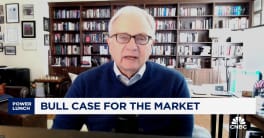The consensus forecast expects U.S. GDP growth to come in quite a bit better than the two previous quarters, as exports have surged on the weak dollar and the fiscal stimulus package has provided a boost to consumption.
The advance Q2 GDP report is expected to show growth of 2.3% in Thursday's report from the Bureau of Economic Analysis, a significant advance following 1.0% growth in Q1 and a dismal 0.6% rate in the final quarter of 2007. However, forecasts are abnormally wide for the report, ranging from 0.9% to 4.2%.
"I haven't seen a range like this in a while," said Guy Lebas, fixed income strategist from Janney Montgomery Scott.
TD Securities senior economics strategist Charmaine Buskas said the downbeat forecasts likely expect less impact from net exports and the tax rebates, but she said the boost in May retail sales suggests the American consumer has been resilient. She also said exports continued to grow strongly through the second quarter and likely accounted for more than half of her forecasted growth pace of 2.2%.
Global Insight economists went even further, commenting that growth is being driven "almost entirely by net exports," which they said "must be viewed as godsend in view of a weak domestic economy."
If the consensus is correct, markets will view the results as upbeat, Buskas said, but the headline won't tell the whole story because the positive effects of the fiscal stimulus package are only temporary and there are already growing hurdles for the consumer in the current quarter.
On the less optimistic side, 4Cast's senior economist David Sloan said the primary downside risk comes from inventories, which he said have been cut sharply and will come in really weak. Despite his lower-than-consensus forecast of 1.7% growth, however, Sloan said the report offer a "reasonably encouraging breakdown," adding that minus inventories, GDP should be "quite healthy."
Moreover, a weak inventories figure suggests businesses haven't been caught off guard by the economic slowdown, and falling inventories may allow businesses in the third-quarter to build up supply.
On the more optimistic side, National City's chief economist Richard DeKaser is looking for 2.8% growth in the quarter. He said consumers have been spending rather than saving the tax rebates and consumption should be "especially impactful" in the report.
DeKaser also said foreign trade should see a 10% inflation-adjusted gain, as exports are holding up on account of a weak greenback, while imports are down significantly.
Forecasts for Q2 growth are generally much more optimistic than those made a few months ago. DeKaser noted the Blue Chip Economic Indicators forecast was looking for only a 1.2% growth pace as late as July 10, while back on June 10 the forecast was 0.2%.
As with every advance Q2 GDP report, revisions for the prior three years will also be released, giving another reason for markets to look past the headline.
Scott Brown, an economist from Raymond James, said the market will be concerned that figures for the previous two quarters may be revised lower, possibly even into negative growth. The revisions could also be positive, of course, but Brown said an upside surprise wouldn't signal that the worst is behind us.
Looking at the rest of the year, Paul Ashworth, senior U.S. economist from Capital Economics, said Q2's faster growth should nudge annual GDP growth up to 1.4%, from their previous estimate of 1.2%.
"Nevertheless, we are becoming more downbeat about the prospects for the first half of 2009 and have pulled our forecast for GDP growth next year down to 0.8%, from 1.0%," he said.
The quarterly GDP reports released by the BEA are issued in sets of three with advance, preliminary and final versions.
By Patrick McGee and edited by Cristina Markham







